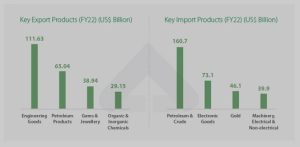The patterns of national exports and imports can undergo changes due to various factors, including economic trends, geopolitical shifts, technological advancements, and global events. As of my last knowledge update in January 2022, here are some general trends and factors that have been influences changing patterns in national exports and imports:

Changing Patterns in National Exports and Imports
-
Table of Contents
ToggleEconomic Shifts:
- Economic growth and recessions in different countries can impact the demand for goods and services, influencing the volume and composition of exports and imports.
-
Global Supply Chain Disruptions:
- Disruptions in global supply chains, as seen during events like the COVID-19 pandemic, can lead to changes in the sources and destinations of exports and imports.
-
Trade Agreements and Tariffs:
- Changes in trade agreements and tariff policies between countries can significantly affect the competitiveness of certain industries and alter trade patterns.
-
Technological Advancements:
- Advances in technology can lead to changes in the types of products and services traded. For example, the rise of digital goods and services can impact traditional manufacturing-based trade patterns.
-
E-commerce Growth:
- The growth of e-commerce has led to changes in consumer behavior and supply chain dynamics, influencing the types of products being traded and the channels through which they are distributed.
-
Geopolitical Events:
- Geopolitical tensions, conflicts, and diplomatic relations between countries can impact trade patterns, leading to shifts in alliances and trading partners.
-
Environmental and Sustainability Considerations:
- Increasing awareness of environmental issues and sustainability concerns has led to changes in consumer preferences and regulations, influencing the types of products that are traded.
-
Currency Fluctuations:
- Changes in currency exchange rates can impact the competitiveness of exports and imports. A strong or weak currency can affect the cost of goods and services in international trade.
-
Energy Prices:
- Fluctuations in energy prices, especially for commodities like oil, can impact the cost of production and transportation, influencing trade patterns.
-
Political Changes:
- Political changes, such as changes in government policies and leadership, can have implications for trade relations and trade patterns.
-
Health and Safety Concerns:
- Events like pandemics or health-related crises can impact the movement of goods and people, leading to changes in trade patterns and preferences.
-
Diversification of Markets:
- Countries and businesses may seek to diversify their export and import markets to reduce dependence on specific regions or industries.
-
Investments in Infrastructure:
- Improvements in transportation and logistics infrastructure can enhance trade capabilities and influence trade routes.
It’s important to note that these trends are subject to change, and the specific factors influencing national exports and imports can vary based on the economic, political, and social context. Regular analysis and monitoring of global economic conditions and trade policies are essential to understanding and adapting to changing trade patterns. For the latest and most accurate information, it’s advisable to refer to current economic reports and trade statistics.
